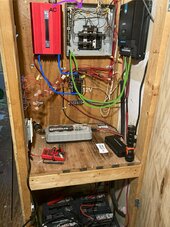CleverTomato
New Member
I think I am in the right spot. Hours of google. Factory videos and manuals. DIY channels on youtube. (Thanks to everyone that takes the time to teach...you are all amazing!!!!)
Inheritied a house: 12V DC lights, ceiling fans, refrigerator. AC wall outlets for other things. 4 ET 310W (2 extra not connected) Renogy 60A MPPT Charge controller. 4 6V deep cycle batteries. 2 in series paralelled with 2 in series. So 12V with 26amps (i think). 2000W Bestek inverter AC and DC.
Set up... Panels --> controller --> load output to 12V. Panels --> controller --> batteries --> inverter
VERY simply stated...i understand that my Renogy Charge controller does this: Sends sun energy directly to my DC gadgets through load output in the daylight. Charges my batteries. Batteries go to inverter for AC. At night batteries power all.
Understaning it may not be a real thing... What I want: I want solar to power my DC during the day and charge my batteries. At night I want batteries to do all.
But I don't want to have to change it all manually. At present I am not able to find 'how' or an example of...or get this. I set my load output (Light + 10)...all works going into the dark...in the morning it just shuts off...so 12V all goes off. Then have to manually turn load on to get back to panel--> controller--> DC.
Thoughts...Advise... And thank you in advace to all!.... and at the end of the day... What...Me Worry?
Inheritied a house: 12V DC lights, ceiling fans, refrigerator. AC wall outlets for other things. 4 ET 310W (2 extra not connected) Renogy 60A MPPT Charge controller. 4 6V deep cycle batteries. 2 in series paralelled with 2 in series. So 12V with 26amps (i think). 2000W Bestek inverter AC and DC.
Set up... Panels --> controller --> load output to 12V. Panels --> controller --> batteries --> inverter
VERY simply stated...i understand that my Renogy Charge controller does this: Sends sun energy directly to my DC gadgets through load output in the daylight. Charges my batteries. Batteries go to inverter for AC. At night batteries power all.
Understaning it may not be a real thing... What I want: I want solar to power my DC during the day and charge my batteries. At night I want batteries to do all.
But I don't want to have to change it all manually. At present I am not able to find 'how' or an example of...or get this. I set my load output (Light + 10)...all works going into the dark...in the morning it just shuts off...so 12V all goes off. Then have to manually turn load on to get back to panel--> controller--> DC.
Thoughts...Advise... And thank you in advace to all!.... and at the end of the day... What...Me Worry?



